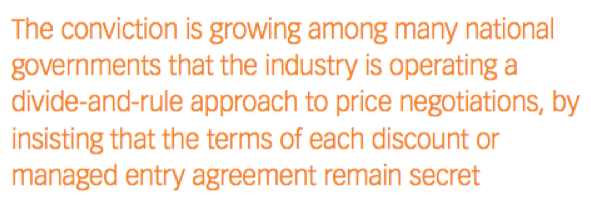EU Countries Square Up to Pharma on Prices
Pharmaceutical Executive
The recent EFPIA and EU health council conferences highlight the growing divisions-and resentments-between industry and governments in Europe.
In a week last month that saw both the annual conference of the European Federation of Pharmaceutical Industries and Associations (EFPIA) and the European Union health council, it was inevitable that the distinct positions of drug firms and government ministers should be on display. It was equally inevitable that their customary polite acknowledgements of interdependence and mutual interest should fray a little at the edges under the closer scrutiny that these two events provoked.
Innovation argument
EFPIA got in the first strike to win the high ground, with a dynamic new agenda under dynamic new leadership, focused on “the exciting wave of pharmaceutical innovation which is transforming the lives of patients and the way we deliver healthcare.” With a series of highly-mediatized pledges in which the organization’s membership undertook to push for new cures, the industry depicted itself as the savior-in-waiting. The industry needed only, it suggested, an environment “to foster and support research and development in Europe.”
Industry speakers lined up to boast of achievements and to dangle promises of more and better to come. Jean-Christophe Tellier, the CEO of UCB, claimed the value of the industry’s products was far in excess of the investment, as demonstrated by increasing longevity. According to Tellier, to secure a healthy future, “our focus on innovation is key.” Eduardo Bravo, CEO of Tigenix, banged the drum for smaller firms-he is also the current president of the European Biopharmaceutical Enterprises, EFPIA’s subset of smaller health biotech companies. Most orphan medicines come from smaller organizations, he said. Nathalie Moll, the new director-general of EFPIA, described Europe as a “lighthouse of research” in the world. And the new EFPIA president, Stefan Oschmann, CEO of Merck KGaA, Darmstadt, Germany, highlighted “the transformational potential of big data” and the prospect it offers of faster development of innovative medicines.
The narrative didn’t go entirely unchallenged, even on EFPIA turf. Sharing the podium with industry luminaries, the European Commission’s deputy-director general for health, Martin Seychell, toyed with a needle around the industry’s balloon, without directly pricking it. Yes, innovation is key to the transformation of healthcare, he agreed. But not just any old innovation-and not necessarily pharmaceutical innovation, he argued.
He challenged Tellier’s claim of value for money in extended lifespans: longer life, perhaps, but not better quality. A much-needed radical shake-up of the current healthcare model should direct more investment toward prevention, primary care, or the workforce. There is still too much unmet need, and “we have a problem of access to care,” from country to country and across socioeconomic groups, and even with some member states facing drug shortages, he said. At present, the timing of health intervention-and that means reliance on drugs to produce cures-is “suboptimal.”
Seychell also nuanced-very heavily-the industry call for incentives for innovation. Against the background of an ongoing Commission review of EU incentive schemes for drug development, he conceded that incentives are “absolutely necessary for a sector like this.” But, he went on, they have to be “the right incentives, for now and the future.”
The Commission review is a direct response to anguished reflections in the EU health council just a year ago about drug companies abusing the current incentive schemes for orphan and pediatric drugs, and making exorbitant price demands. With high prices for medicines and growing strains on healthcare systems, “the landscape is changing,” Seychell warned. “Healthcare expenditure is an investment-but what is the return?” Incentives must be evidence-based, he said, and “we must prove that we have the right incentives, or whether we need different or new ones.”
The access obstacle
Where Seychell was specific, the discussion in the health council two days later was more general, but a public session displayed some equally pointed ministerial skepticism about the pharma sector. An innocuously-titled debate about strengthening inter-governmental cooperation in overall healthcare provided a forum for some sharp barbs about excessive drug prices. Chris Fearne, the Maltese health minister, who chaired the meeting, opened the discussion with a candid allusion to the “obstacle” represented by the “high price tags” for medicines, and the issue of access became the leitmotif of the debate.
From the relatively mild reflection that cooperation could help in “access to health technologies arising inter alia from therapeutic innovation, in particular in the field of rare diseases, and the development of personalized medicine,” the final conclusions moved on to more confrontational language: countries were invited “to cooperate in order to increase transparency in the pricing of pharmaceuticals, which should put the member states in a better position when negotiating with the industry.”
Ireland’s health minister, bruised by a recent-failed-battle with Vertex to obtain satisfactory discounts on its cystic fibrosis treatment, encouraged countries to challenge drug firms and their pricing practices, because “the prices that some companies with a monopoly are seeking to charge mean products will never reach patients.” Hungary and Lithuania urged cooperation on transparency of medicines prices, to ease access across Europe. Greece wanted a cooperative framework to overcome “the injustice of medicines,” and Denmark wanted equal access and the establishment of “fair pricing of pharmaceuticals.”
The enthusiasm for closer cooperation to tackle drug prices was not universal. Germany stood out firmly against any form of mandatory cooperation, although it signed up to the conclusions-but the overall sentiment was strong enough and shared widely enough to make clear that the momentum in this European trend is largely one-way, and not industry’s way. Even before health ministers met, Malta-in the closing days of its six-months term in charge of EU business-had put its own spin on the drug prices debate by presenting a report on similar discussions that had taken place over the previous few months.
The Maltese report, based on a series of informal meetings among EU health ministers and between ministers and European drug industry bosses, made clear the Maltese view that the shift toward greater transparency on drug pricing in Europe is irreversible. It focused particularly on a “roundtable” meeting of drug company CEOs,

national health ministers and patient organizations that the presidency hosted in Valletta in May. It recorded the meeting’s focus on “sustainable prices of new medicines” and “increasing transparency,” and it emphasized an agreement among health ministers the day before the roundtable, to explore cooperation on information, price negotiations and joint procurement.
“Meaningful changes are needed in the mechanisms of pharmaceutical pricing,” according to the Maltese report, highlighting “improving price transparency and narrowing the gaps between retail and negotiated prices.”
Pricing pile-on
Remorselessly, relentlessly, the pressures are mounting on current drug industry pricing practice. The conviction is growing among many national governments that the industry is operating a divide-and-rule approach to price negotiations, by insisting that the terms of each discount or managed entry agreement remain secret. And resentment is growing just as fast. At the EFPIA meeting, Tellier grudgingly acknowledged that the industry has not done a very good job in explaining its approach to prices, its links to value, and its contribution to outcomes. Judging from the political operating context right now, he is right. And it may be time to do more about it.
Reflector is Pharmaceutical Executive’s correspondent in Brussels

Addressing Disparities in Psoriasis Trials: Takeda's Strategies for Inclusivity in Clinical Research
April 14th 2025LaShell Robinson, Head of Global Feasibility and Trial Equity at Takeda, speaks about the company's strategies to engage patients in underrepresented populations in its phase III psoriasis trials.
Beyond the Prescription: Pharma's Role in Digital Health Conversations
April 1st 2025Join us for an insightful conversation with Jennifer Harakal, Head of Regulatory Affairs at Canopy Life Sciences, as we unpack the evolving intersection of social media and healthcare decisions. Discover how pharmaceutical companies can navigate regulatory challenges while meaningfully engaging with consumers in digital spaces. Jennifer shares expert strategies for responsible marketing, working with influencers, and creating educational content that bridges the gap between patients and healthcare providers. A must-listen for pharma marketers looking to build trust and compliance in today's social media landscape.